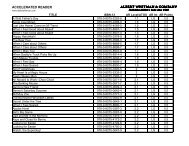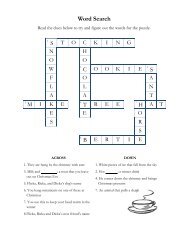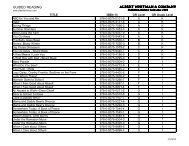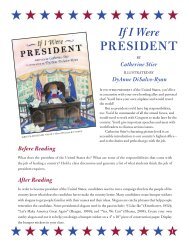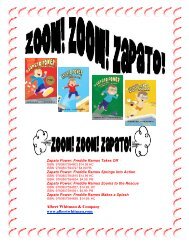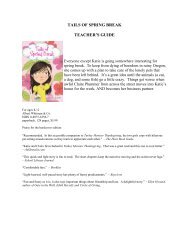Shanté Keys and the New Year's Peas Activity - Albert Whitman ...
Shanté Keys and the New Year's Peas Activity - Albert Whitman ...
Shanté Keys and the New Year's Peas Activity - Albert Whitman ...
You also want an ePaper? Increase the reach of your titles
YUMPU automatically turns print PDFs into web optimized ePapers that Google loves.
<strong>Activity</strong> Guide<br />
for<br />
<strong>Shanté</strong> <strong>Keys</strong> <strong>and</strong><br />
<strong>the</strong> <strong>New</strong> Year’s<br />
<strong>Peas</strong><br />
Book by Gail Piernas-Davenport & illustrated by Marion Eldridge © 2007<br />
<strong>Albert</strong> <strong>Whitman</strong> & Company<br />
Guide Compiled by Gail Piernas-Davenport<br />
for Educators in Grades K-4<br />
© 2008 - 2010<br />
Based on <strong>the</strong> State of Illinois<br />
Learning St<strong>and</strong>ards<br />
Multicultural Resources for a Multicultural World
Page<br />
Introduction 2<br />
Subject Area Activities<br />
Fine Arts<br />
o Party Hat 3<br />
o <strong>New</strong> Year’s at My House! 3<br />
English Language Arts<br />
o Poetry Warm‐up: Relay Rhyming 5<br />
o Read to Write: Analyzing Text 6<br />
o Writing Resolutions 7<br />
o Reader’s Theater 7<br />
Ma<strong>the</strong>matics<br />
o Making a Bar Graph 11<br />
Science<br />
o Growing Black‐eyed <strong>Peas</strong> 12<br />
Social Science/History<br />
o Traditions of Chinese <strong>New</strong> Year 14<br />
Social Science/Geography<br />
o <strong>Peas</strong> around <strong>the</strong> World: Map <strong>Activity</strong> 16<br />
Physical Development & Health<br />
o Studying <strong>the</strong> Food Pyramid 17<br />
o Pyramid Blast‐off Game 18<br />
Social/Emotional Learning<br />
o Character Education Discussion 19<br />
Just for Fun Sheets<br />
Lucky Food Worksheet 20<br />
Chinese <strong>New</strong> Year Word Scramble 21<br />
Answer Sheet 22<br />
Resources<br />
Works Consulted 23<br />
Web Resources 25<br />
Final Text of <strong>Shanté</strong> <strong>Keys</strong> 26<br />
- 1-<br />
Contents
INTRODUCTION<br />
Happy <strong>New</strong> Year!<br />
For <strong>the</strong> classroom teacher, <strong>Shanté</strong> <strong>Keys</strong> is <strong>the</strong> perfect book to use throughout <strong>the</strong><br />
school year, especially in <strong>the</strong> fall <strong>and</strong> winter.<br />
The traditional American <strong>New</strong> Year’s is a non‐religious celebration centered on<br />
January 1st. Studying <strong>Shanté</strong> <strong>Keys</strong>, however, can expose students to <strong>the</strong><br />
interesting traditions <strong>and</strong> timing of o<strong>the</strong>r countries’ celebrations in a positive<br />
manner. And as we live in a multicultural society, students in many classrooms<br />
will see <strong>the</strong>ir own traditions represented in <strong>the</strong> book.<br />
While <strong>the</strong> main story of <strong>Shanté</strong> <strong>Keys</strong> is about food traditions, as you can see from<br />
<strong>the</strong> following activities, <strong>the</strong> book can be used in many different subject areas.<br />
Although <strong>the</strong> guide begins with a party activity <strong>and</strong> food is always a fun place to<br />
start to experience o<strong>the</strong>r cultures, multiculturalism involves much more than<br />
food <strong>and</strong> festivals. For <strong>the</strong> convenience of <strong>the</strong> teachers in my home state, this<br />
activity guide has been written to correspond to <strong>the</strong> State of Illinois teaching<br />
st<strong>and</strong>ards for <strong>the</strong> early primary grades. These should be similar to <strong>the</strong><br />
educational goals of any state.<br />
Feel free to use any of <strong>the</strong>se ideas in conjunction with <strong>the</strong> book. If you want to<br />
share your experiences of using <strong>the</strong> book in your classroom, please drop me a<br />
note or photos!<br />
- 2-<br />
Gail<br />
Gail Piernas‐Davenport<br />
gail@gpdavenport.com
FINE ARTS<br />
SUBJECT AREA ACTIVITIES<br />
STATE GOAL 26: Through creating <strong>and</strong> performing, underst<strong>and</strong> how works of art<br />
are produced.<br />
B. Apply skills <strong>and</strong> knowledge necessary to create <strong>and</strong> perform in one or more of <strong>the</strong> arts.<br />
26.B.1d Visual Arts: Demonstrate knowledge <strong>and</strong> skills to create visual works of art using<br />
manipulation, eye-h<strong>and</strong> coordination, building <strong>and</strong> imagination.<br />
Party Hat<br />
Children love celebrations! Designate a day <strong>and</strong> time for your class’ <strong>New</strong> Year’s<br />
celebration. If homemade treats are allowed at your school, ask parents to donate<br />
<strong>the</strong>m. Encourage <strong>the</strong>m to share treats particular to <strong>the</strong>ir cultures.<br />
Prior to <strong>the</strong> party, have <strong>the</strong> children make <strong>the</strong>ir own <strong>New</strong> Year’s party hats, or a<br />
crown like <strong>Shanté</strong> is wearing on <strong>the</strong> cover of <strong>the</strong> book. (A pattern follows for <strong>the</strong><br />
hat.)<br />
If you make <strong>the</strong> hat at <strong>the</strong> size printed on <strong>the</strong> following sheet, it will be a very<br />
small hat, so you will need to enlarge it. If you don’t have a copy machine that<br />
can do <strong>the</strong> job, use an overhead projector. To enlarge <strong>the</strong> pattern, copy <strong>the</strong> sheet<br />
on a transparency sheet. Tape a sheet of large construction paper on <strong>the</strong> board or<br />
wall <strong>and</strong> project <strong>the</strong> transparency on <strong>the</strong> paper. Adjust <strong>the</strong> size of <strong>the</strong> image to<br />
<strong>the</strong> proper size to create a hat to fit <strong>the</strong> heads of your students. Trace <strong>the</strong> image<br />
on <strong>the</strong> paper to create a pattern.<br />
Before <strong>the</strong> designated time, have <strong>the</strong> children put on <strong>the</strong>ir hats. Have some fun<br />
<strong>and</strong> countdown to <strong>the</strong> time. So if <strong>the</strong> party is to begin at 12 noon, for example,<br />
use <strong>the</strong> classroom clock to countdown 10‐9‐8‐7. . . !<br />
<strong>New</strong> Year’s at My House!<br />
Have students draw a picture or make a collage of what <strong>the</strong> parties would look<br />
like if <strong>Shanté</strong> came to <strong>the</strong>ir houses for a <strong>New</strong> Year’s celebration! Here are some<br />
questions to get <strong>the</strong>m to think about <strong>the</strong> elements in <strong>the</strong>ir picture:<br />
What are <strong>the</strong> people wearing?<br />
What are <strong>the</strong>y eating?<br />
Is it a celebration with an extended family, or just <strong>the</strong> people who live in<br />
your house?<br />
Does your family celebrate on January 1 st or ano<strong>the</strong>r time of <strong>the</strong> year?<br />
- 3-
- 4-<br />
Enlarge this pattern to fit on a large<br />
sheet of construction paper. Copy or<br />
print <strong>the</strong> pattern on <strong>the</strong> paper, cut it<br />
out on <strong>the</strong> black lines, roll it into a<br />
cone which will fold <strong>the</strong> straight edge<br />
in half, <strong>and</strong> <strong>the</strong>n glue one side of <strong>the</strong><br />
straight edge under <strong>the</strong> o<strong>the</strong>r side<br />
<strong>and</strong> let dry. Staple both ends of a<br />
thin piece of elastic onto opposite<br />
sides of <strong>the</strong> bottom edge of <strong>the</strong> hat<br />
so it fits under <strong>the</strong> chin.
ENGLISH LANGUAGE ARTS<br />
STATE GOAL 1: Read with underst<strong>and</strong>ing <strong>and</strong> fluency.<br />
STATE GOAL 2: Read <strong>and</strong> underst<strong>and</strong> literature representative of various<br />
societies, eras <strong>and</strong> ideas.<br />
STATE GOAL 3: Write to communicate for a variety of purposes.<br />
STATE GOAL 4: Listen <strong>and</strong> speak effectively in a variety of situations.<br />
STATE GOAL 5: Use <strong>the</strong> language arts to acquire, assess <strong>and</strong><br />
communicate information.<br />
Language arts include reading, writing, speaking, listening <strong>and</strong> <strong>the</strong> study of literature. Language<br />
arts skills are so intertwined <strong>and</strong> overlapping that I have not tied an activity to a particular goal.<br />
Poetry Warm-up: Relay Rhyming<br />
<strong>Shanté</strong> <strong>Keys</strong> is written completely in rhyme with each verse of <strong>the</strong> book ending<br />
in <strong>the</strong> “eeze” sound. Most books don’t carry <strong>the</strong>ir rhyming patterns to such<br />
extremes, but rhyme <strong>and</strong> rhythm are important tools in writing poetry.<br />
Get your students minds revved up for rhyme with a relay race. Kids love to<br />
compete, <strong>and</strong> in this race <strong>the</strong>re is no loser. All of <strong>the</strong> children can benefit from<br />
this creative activity. You can also use this activity in conjunction with a phonics<br />
lesson to help children to identify phonemes.<br />
First, organize <strong>the</strong> class into rows of relay teams. If your classroom is organized<br />
into straight rows of seats, you will only need to make sure <strong>the</strong> teams are equal<br />
in size.<br />
Take a sheet of lined paper for each team. Write one word at <strong>the</strong> top of each<br />
row’s sheet. Select words that have many one or two syllable rhymes. These can<br />
be words from <strong>the</strong> students’ spelling lists or words studied in phonics.<br />
Suggestions are:<br />
brain (ain sound) sale (ale) knew (ew) four (ore) goal (ole)<br />
glow (o) eyes (ize) mop (op) hide (ide) here (eer)<br />
Tell <strong>the</strong> students that when you say, “Start,” <strong>the</strong> student at <strong>the</strong> head of each row<br />
will turn over <strong>the</strong> paper. The first person will write a word that rhymes with <strong>the</strong><br />
word on <strong>the</strong> sheet <strong>and</strong> <strong>the</strong>n pass it to <strong>the</strong> person behind her/him.<br />
The team that finishes first with <strong>the</strong> most true rhymes wins!<br />
- 5-
Read to Write: Analyzing Text<br />
It’s <strong>the</strong> first advice writers give aspiring writers: In order to be a writer, you have<br />
to read a lot. As your students gain <strong>and</strong> refine <strong>the</strong>ir writing skills, <strong>the</strong> books you<br />
read with <strong>the</strong>m <strong>and</strong> <strong>the</strong> books <strong>the</strong>y read <strong>the</strong>mselves will help <strong>the</strong>m grow as<br />
writers.<br />
When writers seek to undertake writing poetry or picture books, one of <strong>the</strong> first<br />
things some writers will do is write out or type <strong>the</strong> text of many books or poems<br />
to study <strong>the</strong> pieces.<br />
Give <strong>the</strong> students <strong>the</strong> text of <strong>Shanté</strong> <strong>Keys</strong> (a copy is at <strong>the</strong> end of this guide) <strong>and</strong><br />
read it without <strong>the</strong> book <strong>and</strong> pictures. After reading it, have <strong>the</strong> students make<br />
observations about <strong>the</strong> text of <strong>the</strong> book. Some observations might be:<br />
There aren’t many words. (The main text without back matter is just 396<br />
words.)<br />
The book is in rhyme.<br />
The rhymes all have <strong>the</strong> same ending (“eeze”).<br />
Most of <strong>the</strong> verses have 11 beats.<br />
Some phrases repeat (i.e., “Come join us for dinner so you can try peas.”)<br />
The protagonist is a girl.<br />
There is a problem in <strong>the</strong> story (Gr<strong>and</strong>ma forgot <strong>the</strong> peas).<br />
The child solves <strong>the</strong> problem in <strong>the</strong> story.<br />
The story has a happy ending (<strong>Shanté</strong> finds <strong>the</strong> peas <strong>and</strong> everyone enjoys<br />
<strong>New</strong> Year’s dinner).<br />
Type out <strong>the</strong> texts of o<strong>the</strong>r rhyming picture books <strong>and</strong> have students do <strong>the</strong> same<br />
exercise. Do <strong>the</strong> books have anything in common? How are <strong>the</strong>y different?<br />
Hopefully, students will see that while <strong>the</strong> stories of <strong>the</strong> books are not similar<br />
(some are serious or nonfiction, while o<strong>the</strong>rs are fiction <strong>and</strong> may be funny), <strong>the</strong>y<br />
have many of <strong>the</strong> same elements (repetition, a central problem, etc.). A few of<br />
my favorites are<br />
“Falling for Rapunzel” by Leah Wilcox, illustrated by Lydia Monks<br />
“Goodnight Moon” by Margaret Wise Brown, illustrated by Clement<br />
Hurd<br />
“Green Eggs <strong>and</strong> Ham” by Dr. Seuss<br />
“Iron Horse” by Verla Kay, illustrated by Michael McCurdy<br />
- 6-
“Over in <strong>the</strong> Meadow” by Olive A. Wadsworth, illustrated by Ezra Jack<br />
Keats<br />
“Stopping by Woods on a Snowy Evening” by Robert Frost, illustrated by<br />
Susan Jeffers<br />
“Ten Little Lambs” by Alice B. McGinty, illustrated by Melissa Sweet<br />
(internal rhyme)<br />
“What Kind of Seeds Are These” by Heidi Bee Roemer, illustrated by<br />
Olena Kassian<br />
This analysis can be a prelude to <strong>the</strong> students writing <strong>the</strong>ir own rhyming poems<br />
or books.<br />
Writing Resolutions<br />
We adults often think of things we want to improve about ourselves on January<br />
1 st . But what about your students? First, have <strong>the</strong>m write three things <strong>the</strong>y would<br />
like to improve about <strong>the</strong>mselves during <strong>the</strong> year. Explain that it doesn’t have to<br />
be anything earth shattering—it can be as simple as<br />
“I will go to bed on time.”<br />
“I will play outside more.”<br />
“I will eat my veggies, even if I don’t like <strong>the</strong>m.”<br />
Now that students have thought about <strong>the</strong> things <strong>the</strong>y can do to improve<br />
<strong>the</strong>mselves, have <strong>the</strong> students break into groups to discuss <strong>and</strong> write <strong>the</strong><br />
resolutions <strong>the</strong>y can make as a class to improve <strong>the</strong>ir classroom <strong>and</strong> <strong>the</strong>ir school.<br />
This, also, does not have to be huge. It can be as simple as <strong>the</strong> students will put<br />
<strong>the</strong>ir chairs in when <strong>the</strong>y leave <strong>the</strong> lunchroom, or <strong>the</strong>y can pick up paper around<br />
<strong>the</strong> school grounds. Direct students to write <strong>the</strong>ir resolutions in complete<br />
sentences. Post <strong>the</strong>se on a bulletin board so <strong>the</strong> class can monitor its progress in<br />
achieving its resolutions.<br />
Reader's Theater<br />
If you are looking for opportunities to utilize oral reading in your classroom, use <strong>Shanté</strong><br />
<strong>Keys</strong> as a Readerʹs Theater! Having <strong>the</strong> students read as <strong>the</strong> different characters will keep<br />
<strong>the</strong>m engaged in <strong>the</strong> story while giving <strong>the</strong>m fluency training. Iʹve reworked <strong>the</strong> script<br />
to identify <strong>the</strong> speaking parts, added narrators to make smoo<strong>the</strong>r transitions, <strong>and</strong> added<br />
some lines to fill out <strong>the</strong> parts. All of this should make it easy for you to perform in <strong>the</strong><br />
classroom.<br />
- 7-
SHANTÉ KEYS AND<br />
THE NEW YEAR’S PEAS<br />
by Gail Piernas-Davenport<br />
Adapted for Reader’s Theater by <strong>the</strong> author, from her picture book published by<br />
<strong>Albert</strong> <strong>Whitman</strong> & Company, Morton Grove, Illinois, 2007<br />
Story copyright © 2007 Gail Piernas-Davenport. Script copyright © 2009, Gail Piernas-<br />
Davenport. This script is free <strong>and</strong> may be copied, shared, <strong>and</strong> performed for any noncommercial<br />
purpose, except it may not be posted online without permission.<br />
PREVIEW: <strong>Shanté</strong> is looking forward to <strong>New</strong> Year’s Day with her family, but <strong>the</strong> day—<strong>and</strong> <strong>the</strong><br />
year—could turn out to be disasterous without her quick thinking.<br />
GENRE: Holiday<br />
CULTURE: Multicultural<br />
THEME: customs, sharing, perseverance<br />
READERS: 12 or more<br />
READER AGES: 5-8<br />
LENGTH: 10 minutes<br />
ROLES: Narrators 1-4, <strong>Shanté</strong> <strong>Keys</strong>, Gr<strong>and</strong>ma Louise, Miss Lee, Mr. MacGhee, Señor Ortiz, Hari,<br />
Auntie Marie, Mom, Chorus (remainder of <strong>the</strong> class)<br />
NOTE: <strong>Shanté</strong> is pronounced “shahn-TAY”; Hari is pronounced “har-EE”<br />
NARRATOR 1: It’s <strong>New</strong> Year’s Day for <strong>the</strong> Family <strong>Keys</strong>.<br />
SHANTÉ KEYS: (happily)<br />
Happy <strong>New</strong> Year, Gr<strong>and</strong>ma Louise!<br />
Mom said we’ll eat lucky <strong>New</strong> Year’s peas.<br />
GRANDMA: (expressing shock)<br />
Mercy, child! I’m weak in <strong>the</strong> knees.<br />
I cooked lots of food, but forgot black-eyed peas!<br />
Chitlins, baked ham, macaroni <strong>and</strong> cheese,<br />
Greens <strong>and</strong> hot cornbread, but no black-eyed peas!<br />
It’s a year of bad luck if we don’t eat cowpeas.<br />
Quick—go to Miss Lee’s <strong>and</strong> borrow some, please!<br />
- 8-
SHANTÉ KEYS: (knocking on Miss Lee’s door)<br />
Happy <strong>New</strong> Year, Miss Lee. It’s <strong>Shanté</strong> <strong>Keys</strong>.<br />
Gram wants to borrow some black-eyed peas.<br />
MISS LEE: My <strong>New</strong> Year is later because I’m Chinese.<br />
I’ll make crisp golden dumplings instead of cowpeas.<br />
SHANTÉ KEYS: I’m sorry to bo<strong>the</strong>r you today, Miss Lee.<br />
Come join us for dinner so you can try peas.<br />
NARRATOR 2: <strong>Shanté</strong> thinks of <strong>the</strong> grocer’s—Mr. MacGhee’s.<br />
SHANTÉ KEYS: (approaching Mr. MacGhee)<br />
Your aisles are stocked with such delicacies.<br />
Why can’t I find lucky black-eyed peas?<br />
MR. MACGHEE: Back home in my Scotl<strong>and</strong>, far overseas,<br />
For <strong>New</strong> Year’s we toast, <strong>and</strong> eat haggis <strong>and</strong> cheese.<br />
SHANTÉ KYES: Happy <strong>New</strong> Year, anyway, Mr. MacGhee.<br />
Come join us for dinner so you can try peas.<br />
NARRATOR 3: Next <strong>Shanté</strong> goes to ask Señor Ortiz.<br />
He’s a wonderful chef with great recipes.<br />
SHANTÉ KEYS: (approaching Sr. Ortiz)<br />
What do you eat for <strong>New</strong> Year’s luck, Chef Ortiz?<br />
If you cook blackeyes, may I borrow some, please?<br />
SEÑOR ORTIZ: I am from Mexico, down by Belize.<br />
For luck, we make noise <strong>and</strong> eat grapes like <strong>the</strong>se.<br />
SHANTÉ KEYS: Happy <strong>New</strong> Year, anyway, Senor Ortiz.<br />
Come join us for dinner so you can try peas.<br />
- 9-
NARRATOR 4: Next <strong>Shanté</strong> will try at her good friend Hari’s.<br />
SHANTÉ KEYS: (approaching Hari)<br />
Hari, do you have lucky black-eyed peas?<br />
For our <strong>New</strong> Year’s meal, may I borrow some, please?”<br />
HARI: We celebrate Diwali with o<strong>the</strong>r Hindu families.<br />
We light lamps <strong>and</strong> eat sweets—but no black-eyed peas.<br />
SHANTÉ KEYS: Thank you, anyway,<br />
Come join us for dinner so you can try peas.<br />
NARRATOR 1: Now <strong>Shanté</strong> is frantic; she’s in a time squeeze.<br />
NARRATOR 2: She thinks hard <strong>and</strong> rushes to Auntie Marie’s.<br />
(<strong>Shanté</strong> at Auntie Marie’s door)<br />
AUNTIE MARIE: I’d have too many if I cooked all of <strong>the</strong>se.<br />
Hon, take what you need of my <strong>New</strong> Year’s peas.<br />
SHANTÉ KEYS: Thanks <strong>and</strong> come eat at Gram’s with me, please!<br />
(<strong>Shanté</strong> <strong>and</strong> Auntie back at Gr<strong>and</strong>ma’s)<br />
NARRATOR 3: Gr<strong>and</strong>ma chops onions to cook with <strong>the</strong> peas.<br />
NARRATOR 4: Auntie adds a coin for luck <strong>and</strong> a pinch of bay leaves,<br />
And <strong>Shanté</strong> cooks <strong>the</strong> rice while Mom oversees.<br />
MOM: <strong>Shanté</strong>, can you get <strong>the</strong> door, please?<br />
Your friends are here for dinner, come to try peas!<br />
CHORUS: (happily, everyone toge<strong>the</strong>r)<br />
The peas are delicious! We all can agree!<br />
Happy <strong>New</strong> Year <strong>and</strong> thank you, <strong>Shanté</strong> <strong>Keys</strong>!<br />
- 10-
MATHEMATICS<br />
STATE GOAL 10: Collect, organize <strong>and</strong> analyze data using statistical methods;<br />
predict results; <strong>and</strong> interpret uncertainty using concepts of probability.<br />
10.A.1a Organize <strong>and</strong> display data using pictures, tallies, tables, charts or bar graphs.<br />
Assessment: Display <strong>and</strong> compare data in a pictograph, table, <strong>and</strong> bar graph with tallies.<br />
Making a Bar Graph<br />
After reading <strong>the</strong> book with or to <strong>the</strong> students, ask <strong>the</strong>se questions. Write <strong>the</strong><br />
tallies on <strong>the</strong> board for each question.<br />
1. How many students eat black‐eyed peas for luck on <strong>New</strong> Year’s Day?<br />
How many people eat o<strong>the</strong>r things for luck in <strong>the</strong> <strong>New</strong> Year’s? List <strong>the</strong>se<br />
<strong>and</strong> tally <strong>the</strong>m.<br />
2. Whose <strong>New</strong> Year begins on January 1? Whose <strong>New</strong> Year begins at a time<br />
o<strong>the</strong>r than January 1 st ? What is <strong>the</strong> name of your holiday?<br />
3. What time do you get to stay up to on <strong>New</strong> Year’s Eve?<br />
Using <strong>the</strong> tallies from one of <strong>the</strong> questions, have <strong>the</strong> students make pictographs,<br />
bar graphs or pie charts to compare <strong>the</strong> different ways to celebrate.<br />
Example:<br />
Foods We Eat for <strong>New</strong> Year’s Luck<br />
Food No. of Students<br />
Black-eyed peas IIII<br />
Grapes IIII I<br />
Herring I<br />
Pork III<br />
Haggis I<br />
Dumplings II<br />
Nothing special IIII<br />
Bar chart:<br />
No. of Students<br />
7<br />
6<br />
5<br />
4<br />
3<br />
2<br />
1<br />
0<br />
- 11-<br />
Special Foods Eaten for <strong>New</strong> <strong>Year's</strong><br />
Foods<br />
Black-eyed peas<br />
Grapes<br />
Herring<br />
Pork<br />
Haggis<br />
Dumplings<br />
Nothing special
SCIENCE<br />
STATE GOAL 12: Underst<strong>and</strong> <strong>the</strong> fundamental concepts, principles <strong>and</strong><br />
interconnections of <strong>the</strong> life, physical <strong>and</strong> earth/space sciences.<br />
12.B.1b Describe how living things depend on one ano<strong>the</strong>r for survival.<br />
Assessment: Students will apply <strong>the</strong> process of scientific inquiry to explore how living<br />
things are dependent on one ano<strong>the</strong>r for survival.<br />
Growing Black-eyed <strong>Peas</strong><br />
Black‐eyed peas or cowpeas like hot wea<strong>the</strong>r much better than cold wea<strong>the</strong>r. The<br />
states that produce <strong>the</strong> majority of black‐eyed peas are California, Texas, <strong>and</strong><br />
Arizona. These states produce a combined total of 20 – 30,000 metric tons of <strong>the</strong><br />
bean each year. That’s a lot of beans!<br />
Africa produces <strong>the</strong> most black‐eyed peas, with <strong>the</strong> countries of Niger <strong>and</strong><br />
Nigeria leading production. O<strong>the</strong>r countries that produce <strong>the</strong> bean are Brazil,<br />
Haiti, India, Myanmar, Sri Lanka, Australia, Bosnia <strong>and</strong> Herzegovina.<br />
You can try growing black‐eyed peas in your classroom! You can purchase seeds<br />
online at places like Local Harvest or Main Street Seed <strong>and</strong> Supply Company. Be<br />
aware that seeds take 60 days to reach maturity.<br />
Have <strong>the</strong> students prepare <strong>the</strong> soil <strong>and</strong> seeds for planting. Students should be<br />
involved in <strong>the</strong>ir daily care, such as watering, <strong>and</strong> have <strong>the</strong>m make <strong>and</strong> record<br />
observations each day on <strong>the</strong> progress of <strong>the</strong> beans.<br />
- 12-
Questions for consideration:<br />
Where is <strong>the</strong> best place in <strong>the</strong> room to locate <strong>the</strong> plants?<br />
What do <strong>the</strong> plants need to stay alive <strong>and</strong> thrive?<br />
How does growing <strong>the</strong> beans inside compare to <strong>the</strong> conditions in which a<br />
farmer would grow <strong>the</strong>m outside?<br />
The temperature in <strong>the</strong> room fluctuates or changes depending on <strong>the</strong><br />
temperature outside. How does this affect <strong>the</strong> plants?<br />
Weeds are a concern to farmers raising all types of crops. Weeding can<br />
ei<strong>the</strong>r be manual, such as hoeing, or chemical, with herbicides. How does<br />
<strong>the</strong> use of chemicals affect <strong>the</strong> larger environment?<br />
Pest control is also an issue for black‐eyed pea growers, especially in<br />
Africa where an increased harvest could mean more food for millions.<br />
Scientists have been working on bioengineering a plant resistant to pests.<br />
What are <strong>the</strong> concerns people have about using genetics to affect food<br />
crops?<br />
How has global warming affected <strong>the</strong> growing seasons in different areas<br />
of <strong>the</strong> country <strong>and</strong> <strong>the</strong> world?<br />
The scientific name for black‐eyed peas is Vigna unguiculata. You can go to <strong>the</strong><br />
Library of Congress Science Reference Services<br />
(http://www.loc.gov/rr/scitech/mysteries/blackeyedpeas.html) to see pictures of<br />
<strong>the</strong> plant in bloom <strong>and</strong> <strong>the</strong> bean pod fully grown.<br />
The book Beans by Melanie Mitchell (First Step Nonfiction, Lerner Publications,<br />
2003) is a good primary level book that pictures <strong>the</strong> different stages of bean<br />
development.<br />
- 13-
SOCIAL SCIENCE/HISTORY<br />
STATE GOAL 16: Underst<strong>and</strong> events, trends, individuals <strong>and</strong> movements shaping<br />
<strong>the</strong> history of Illinois, <strong>the</strong> United States <strong>and</strong> o<strong>the</strong>r nations.<br />
D. Underst<strong>and</strong> Illinois, United States <strong>and</strong> world social history.<br />
16.D.1 (W) Identify how customs <strong>and</strong> traditions from around <strong>the</strong> world influence <strong>the</strong> local<br />
community.<br />
Assessment: Draw pictures illustrating a tradition <strong>and</strong> custom that originated in ano<strong>the</strong>r<br />
country that is practiced in <strong>the</strong> community <strong>and</strong> write at least one sentence comparing <strong>the</strong><br />
two traditions/customs.<br />
Study <strong>the</strong> Traditions of Chinese <strong>New</strong> Year<br />
In cities all around <strong>the</strong> United States, Chinese Americans celebrate Chinese or<br />
Lunar <strong>New</strong> Year in January or February. Families observe traditions that were<br />
started in China centuries ago. In <strong>the</strong> 1800s, many Chinese men came to America<br />
with <strong>the</strong> hopes of striking it rich in <strong>the</strong> California Gold Rush <strong>and</strong> stayed to work<br />
on building <strong>the</strong> railroad.<br />
Have <strong>the</strong> students study how <strong>the</strong> festivities differ today in America than<br />
yesteryear in China. Some resources are:<br />
“Bringing in <strong>the</strong> <strong>New</strong> Year” by Grace Lin<br />
“Chinatown” by William Low<br />
“Dumpling Soup” by Jama Kim Rattigan, illus. by Lillian Hsu‐Fl<strong>and</strong>ers<br />
“Chinese <strong>New</strong> Year”: www.infoplease.com/spot/chinesenewyear1.html<br />
<br />
Examples of differences:<br />
In China<br />
People lit fires on bamboo sticks to ward off <strong>the</strong> evil spirits<br />
15 days of festivities<br />
Dragon dance performed on 15 th day at Lantern Festival<br />
China was largely a rural society<br />
<br />
In America Today<br />
Fireworks used to celebrate<br />
Celebration often shortened<br />
Dragon dance performed at weekend parade<br />
Many Chinese Americans live in or near big cities<br />
- 14-
Have <strong>the</strong> students take a sheet of construction paper <strong>and</strong> fold <strong>the</strong> sheet in half.<br />
On <strong>the</strong> top, have students draw a traditional Chinese <strong>New</strong> Year from a prior<br />
century. Tell <strong>the</strong> students to draw a scene from a Chinese American celebration<br />
today. Have <strong>the</strong> students write a sentence to compare <strong>the</strong> two scenes.<br />
- 15-
SOCIAL SCIENCE/GEOGRAPHY<br />
STATE GOAL 17: Underst<strong>and</strong> world geography <strong>and</strong> <strong>the</strong><br />
effects of geography on society, with an emphasis on<br />
<strong>the</strong> United States.<br />
A. Locate, describe <strong>and</strong> explain places, regions <strong>and</strong><br />
features on <strong>the</strong> Earth.<br />
17.A.1a Identify physical characteristics places, both<br />
global (e.g., roads, regions, of water).<br />
<strong>Peas</strong> around <strong>the</strong> World: Map <strong>Activity</strong><br />
As you read in <strong>the</strong> Science section, a number of o<strong>the</strong>r countries grow black‐eyed<br />
peas. Some of <strong>the</strong> black‐eyed bean producing countries <strong>and</strong> states are:<br />
1. Angola<br />
2. Australia<br />
3. Benin<br />
4. Bosnia<br />
5. Botswana<br />
6. Brazil<br />
7. Burkina Faso<br />
8. Cameroon<br />
9. Central African<br />
Republic<br />
10. Chad<br />
11. China<br />
12. Congo<br />
13. Côte D’Ivoire<br />
Have <strong>the</strong> students locate <strong>the</strong><br />
countries <strong>and</strong> states on <strong>the</strong> classroom<br />
map, identify <strong>the</strong> continent on which<br />
each country is located, <strong>and</strong> make a<br />
few observations. Is <strong>the</strong> country<br />
mountainous or flat? Is <strong>the</strong>re a good<br />
water supply?<br />
14. Ethiopia<br />
15. Ghana<br />
16. Haiti<br />
17. Herzegovina<br />
18. India<br />
19. Kenya<br />
20. Mali<br />
21. Mauritania<br />
22. Mozambique<br />
23. Myanmar<br />
24. Namibia<br />
25. Niger<br />
26. Nigeria<br />
27. Senegal<br />
- 16-<br />
28. Somalia<br />
29. South Africa<br />
30. Sri Lanka<br />
31. Sudan<br />
32. Togo<br />
33. United States –<br />
Arizona<br />
34. United States –<br />
California<br />
35. United States –<br />
Texas<br />
36. Zambia<br />
37. Zimbabwe<br />
For older students, have <strong>the</strong>m do<br />
some basic research on <strong>the</strong> countries,<br />
using an almanac designed for<br />
students, such as FactMonster.com.<br />
Topics to research include:<br />
Climate—average<br />
temperature<br />
Population<br />
O<strong>the</strong>r food crops
PHYSICAL DEVELOPMENT AND HEALTH<br />
STATE GOAL 23. Underst<strong>and</strong> human body systems <strong>and</strong> factors that influence<br />
growth <strong>and</strong> development.<br />
B. Explain <strong>the</strong> effects of health-related actions on <strong>the</strong> body systems.<br />
23.B.1 Identify healthy actions that influence <strong>the</strong> functions of <strong>the</strong> body (e.g., cleanliness,<br />
proper diet, exercise).<br />
Assessment: Students who meet <strong>the</strong> st<strong>and</strong>ard can explain <strong>the</strong> effects of health related<br />
actions on <strong>the</strong> body systems.<br />
Studying <strong>the</strong> Food Pyramid<br />
Eating a balanced diet is key to good nutrition <strong>and</strong> good health, but it is not <strong>the</strong><br />
only variable in <strong>the</strong> equation. When our bodies have <strong>the</strong> right servings of<br />
nutrients <strong>and</strong> exercise, our minds develop <strong>and</strong> our bodies grow.<br />
It’s easy to integrate<br />
information on black‐<br />
eyed peas in your<br />
nutrition lessons.<br />
Black‐eyed peas are<br />
typically categorized<br />
as a member of <strong>the</strong> bean family, <strong>and</strong> have<br />
great nutritional value. They are low in fat,<br />
high in fiber, <strong>and</strong> are a good source of iron,<br />
protein, <strong>and</strong> folate, <strong>and</strong> have no<br />
cholesterol. In <strong>the</strong> food pyramid, a serving<br />
of black‐eyed peas can be counted ei<strong>the</strong>r as<br />
a serving of vegetables or a serving from<br />
<strong>the</strong> meats <strong>and</strong> beans section.<br />
You can obtain a master of <strong>the</strong> blank food<br />
pyramid for students at<br />
http://teamnutrition.usda.gov/resources/m<br />
pk_coloring.pdf, in <strong>the</strong> MyPyramid for Kids site. (Also, a detailed completed<br />
pyramid poster appears <strong>the</strong>re.) Go over <strong>the</strong> different categories <strong>and</strong> what <strong>the</strong>y<br />
are composed of <strong>and</strong> have students enter <strong>the</strong> proper titles in <strong>the</strong> boxes at <strong>the</strong><br />
bottom. Have <strong>the</strong>m color <strong>the</strong>ir pyramid.<br />
- 17-<br />
Nutrition Facts<br />
Source: Food <strong>and</strong> Nutrition Service,<br />
United States Department of Agriculture<br />
Serving size 1 cup (172g)<br />
Cooked black‐eyed peas without salt<br />
Amount Per Serving<br />
Calories 199 Fat Cal 8<br />
% Daily Value*<br />
Total Fat .9g 1%<br />
Saturated Fat .2g 1%<br />
Cholesterol 0mg 0%<br />
Sodium 6mg 0%<br />
Total Carbohydrate 35g 11%<br />
Dietary Fiber 11g 44%<br />
Sugars 5g<br />
Protein 13g<br />
Vitamin A 0% Vitamin C 1%<br />
Calcium 4% Iron 23%
Pyramid Blast-off Game<br />
As we know, however, food is just <strong>the</strong> beginning of<br />
<strong>the</strong> equation. Exercise plays a key role, but children<br />
usually have no clue about <strong>the</strong> proper amount.<br />
In order to get your students to use <strong>the</strong> information<br />
<strong>the</strong>y gained in studying <strong>the</strong> pyramid <strong>and</strong> to get <strong>the</strong>m<br />
thinking about <strong>the</strong> proper balance of food <strong>and</strong><br />
exercise, play this neat interactive game on <strong>the</strong><br />
MyPyramid.gov website, <strong>the</strong> MyPyramid Blast‐Off<br />
Game (http://www.mypyramid.gov/kids/kids_game.html). Students ages ages 6<br />
– 11 make choices to fuel up <strong>the</strong>ir spaceship with <strong>the</strong> right mix of foods <strong>and</strong><br />
exercise in order to reach Planet Power.<br />
You will need Flash Player 7 (or higher) to play <strong>the</strong> game. It can be downloaded free on<br />
<strong>the</strong> site if your classroom computer does not already have it.<br />
If <strong>the</strong>y are not successful <strong>the</strong> first time (as I wasn’t!), <strong>the</strong>y can return to <strong>the</strong> game,<br />
change <strong>the</strong>ir choices <strong>and</strong> retry <strong>the</strong> trip to Planet Power. Students will see if <strong>the</strong>y<br />
consume too many calories, have enough exercise, <strong>and</strong> make adequate choices in<br />
<strong>the</strong> different parts of <strong>the</strong> pyramid. At <strong>the</strong> end, if <strong>the</strong> student’s mission is<br />
successful, he/she receives a certificate!<br />
FYI: March is Good Nutrition Month.<br />
- 18-
SOCIAL EMOTIONAL LEARNING<br />
State Goal 2: Use social-awareness <strong>and</strong> interpersonal skills to establish<br />
<strong>and</strong> maintain positive relationships.<br />
B: Recognize individual <strong>and</strong> similarities <strong>and</strong> differences.<br />
2B.1b. Describe positive qualities in o<strong>the</strong>rs.<br />
Character Education Discussion<br />
In <strong>the</strong> book, <strong>Shanté</strong> <strong>Keys</strong> demonstrates many of <strong>the</strong><br />
characteristics we would want young students to<br />
emulate. Lead a discussion with your class on how<br />
<strong>Shanté</strong> shows <strong>the</strong> following qualities. Ask <strong>the</strong>m what<br />
<strong>the</strong>y would have done if <strong>the</strong>y were in <strong>Shanté</strong>’s place.<br />
Responsibility<br />
o (<strong>Shanté</strong> accepts <strong>the</strong> assignment from her gr<strong>and</strong>mo<strong>the</strong>r to find <strong>the</strong><br />
peas for dinner <strong>and</strong> makes it her mission to return with <strong>the</strong> peas.)<br />
Acceptance<br />
o (<strong>Shanté</strong> respects <strong>the</strong> traditions of her friends <strong>and</strong> neighbors, even<br />
though <strong>the</strong>y are very different from those of her family.)<br />
Politeness<br />
o (Even when <strong>Shanté</strong> doesn’t find <strong>the</strong> peas she was sent to find at <strong>the</strong><br />
neighbor’s, she thanks her before she leaves.)<br />
Perseverance<br />
o (When she doesn’t find <strong>the</strong> peas at Miss Lee’s, <strong>the</strong> neighbor her<br />
gr<strong>and</strong>mo<strong>the</strong>r told her to try, she keeps searching until she finds<br />
<strong>the</strong>m.)<br />
Friendship/Generosity<br />
o (<strong>Shanté</strong> invites <strong>the</strong> neighbors back to her gr<strong>and</strong>mo<strong>the</strong>r’s to enjoy<br />
her family’s tradition of eating black‐eyed peas.)<br />
Cooperation<br />
o (<strong>Shanté</strong> helps her gr<strong>and</strong>mo<strong>the</strong>r, mo<strong>the</strong>r, <strong>and</strong> aunt by preparing <strong>the</strong><br />
rice to go with <strong>the</strong> black‐eyed peas for <strong>the</strong> family dinner.)<br />
- 19-
JUST FOR FUN<br />
Lucky Food!<br />
Match <strong>the</strong> food eaten to celebrate <strong>the</strong> <strong>New</strong> Year with <strong>the</strong> appropriate country.<br />
Oliebollen<br />
Doughnuts<br />
St. Basil’s Cake<br />
Fried<br />
Dumplings or<br />
jiaozi<br />
Haggis<br />
Black‐eyed <strong>Peas</strong><br />
Grapes<br />
Name ______________________________________________________<br />
- 20-<br />
Greece<br />
Spain<br />
United States<br />
Holl<strong>and</strong><br />
Scotl<strong>and</strong><br />
China
Name __________________________________<br />
Chinese <strong>New</strong> Year Word Scramble<br />
Please unscramble <strong>the</strong> words below.<br />
1. migupnld<br />
2. mono<br />
3. yckul<br />
4. go<strong>and</strong>r<br />
5.<br />
rrieowskf<br />
6. encnalgi<br />
7. eoveplen<br />
8. rsnltean<br />
9. lsfatiev<br />
10. edaarp<br />
11. rluan<br />
12. ciazod<br />
- 21-
Just for Fun Answer <strong>Keys</strong><br />
Food Match<br />
Food Country<br />
Oliebollen Doughnuts Holl<strong>and</strong><br />
St. Basil’s Cake Greece<br />
Fried Dumplings China<br />
Haggis Scotl<strong>and</strong><br />
Black‐eyed <strong>Peas</strong> United States<br />
Grapes Spain<br />
Chinese <strong>New</strong> Year Word Scramble<br />
dumpling<br />
moon<br />
lucky<br />
dragon<br />
fireworks<br />
cleaning<br />
envelope<br />
lanterns<br />
festival<br />
parade<br />
zodiac<br />
Make your own word scrambles <strong>and</strong> puzzles for o<strong>the</strong>r holidays at<br />
http://www.<strong>the</strong>teacherscorner.net/printable‐worksheets/make‐your‐own<br />
- 22-
Works Consulted in writing <strong>the</strong> book <strong>and</strong> this guide<br />
Barkin, Carol <strong>and</strong> Elizabeth James. The Holiday H<strong>and</strong>book. <strong>New</strong> York: Clarion Books,<br />
1994.<br />
Bernhard, Emery. Happy <strong>New</strong> Year! <strong>New</strong> York: Lodestar Books, 1996.<br />
Birch, Beverley. Festivals. Morristown, <strong>New</strong> Jersey: Silver Burdett Company, 1984.<br />
Demi. Happy <strong>New</strong> Year. <strong>New</strong> York: Crown Publishers, 1997.<br />
Erlbach, Arlene. Happy <strong>New</strong> Year Everywhere! Brookfield, Connecticut: The Millbrook<br />
Press, 2000.<br />
Gaer, Joseph. Holidays Around <strong>the</strong> World. Boston: Little Brown <strong>and</strong> Company, 1953.<br />
Hoyt-Goldsmith, Diane. Celebrating Chinese <strong>New</strong> Year. <strong>New</strong> York: Holiday House,<br />
1998.<br />
Johnson, Lois S. Happy <strong>New</strong> Year Round <strong>the</strong> World. U.S.A.: R<strong>and</strong> McNally &<br />
Company, 1966.<br />
Jones, Lynda. Kids Around <strong>the</strong> World Celebrate!: The Best Feasts <strong>and</strong> Festivals from<br />
Many L<strong>and</strong>s. <strong>New</strong> York: John Wiley & Sons, Inc., 2000.<br />
Lin, Grace. Bringing in <strong>the</strong> <strong>New</strong> Year. <strong>New</strong> York: Alfred A. Knopf, 2008.<br />
Low, William. Chinatown. <strong>New</strong> York: Henry Holt <strong>and</strong> Company, Inc., 1997.<br />
“<strong>New</strong> Year Traditions Around <strong>the</strong> World,” www.<strong>the</strong>holidayspot.com.<br />
P<strong>and</strong>ya, Meenal. Here Comes Diwali, <strong>the</strong> Festival of Lights. Welesley, Massachusetts:<br />
MeeRa Publications, 2001.<br />
RESOURCES<br />
Rattigan, Jama Kim. Dumpling Soup. Boston: Little Brown <strong>and</strong> Company, 1993.<br />
Rau, Dana Meachen. <strong>New</strong> Year’s Day. A True Book. <strong>New</strong> York: Children’s Press, 2000.<br />
- 23-
Russell, Joan. “<strong>New</strong> Year’s Day Customs.” The All-Night Coffee House.<br />
http://pages.ivillage.com/joruss/newyear.html.<br />
Simonds, Nina, Leslie Swartz & The Children’s Museum, Boston. Moonbeams,<br />
Dumplings & Dragon Boats. San Diego: Gulliver Books, 2002.<br />
Solomon, Alan, R<strong>and</strong>y Curwen, Alex Rodriguez, Stevenson Swanson, Michael A. Lev.<br />
“A World of <strong>New</strong> Years.” Chicago Tribune Magazine. 14 Sept. 2003: 21+.<br />
Steele, Philip. The World of Festivals. U.S.A.: R<strong>and</strong> McNally, 1996.<br />
Three Guys from Miami. “Hold Your Own Cuban <strong>New</strong> Years Eve Party.” A Cuban<br />
Christmas. http://cuban-christmas.com/newyears.html.<br />
Verma, Jatinder. The Story of Divali. Cambridge, Massachusetts: Barefoot Books, 2002.<br />
Walsh, Kieran. Chinese <strong>New</strong> Year. Holiday Celebrations series. Vero Beach, Florida:<br />
Rourke Publishing LLC, 2003.<br />
- 24-
Web Resources<br />
(These are just a few of <strong>the</strong> many resources available online.)<br />
Black‐Eyed <strong>Peas</strong><br />
Bean Information Northarvest Bean Growers Association<br />
Crop Information Purdue University Extension<br />
Network for <strong>the</strong> Genetic Improvement<br />
of Cowpea for Africa<br />
Yuma Area Ag Council<br />
Thomas Jefferson Institute<br />
Nutrition Beans for Health<br />
Vegetable of <strong>the</strong> Month/Beans ‐ Centers<br />
for Disease Control<br />
University of Michigan Integrative<br />
Medicine<br />
Recipes Melissaʹs Black‐eyed <strong>Peas</strong><br />
Vegetable with More<br />
California Dry Bean Board<br />
Evaluating Multicultural Books Anti‐Defamation League<br />
<strong>New</strong> Year’s<br />
Activities <strong>New</strong> Yearʹs Coloring Sheets<br />
Countdown Countdown <strong>the</strong> Time to <strong>New</strong> Yearʹs<br />
Around <strong>the</strong> World<br />
Greetings How to Say ʺHappy <strong>New</strong> Yearʺ in<br />
Different Languages<br />
Party Ideas Family Fun Magazine<br />
In China Chinese <strong>New</strong> Year<br />
In India Diwali<br />
In Mexico <strong>New</strong> Yearʹs Eve in Mexico<br />
In Scotl<strong>and</strong> Edinburghʹs Hogmanay<br />
Please note: If you received a printed copy of this guide, please visit my website for <strong>the</strong> active links to <strong>the</strong>se sites.<br />
- 25-
Final Text of<br />
<strong>Shanté</strong> <strong>Keys</strong> <strong>and</strong> <strong>the</strong> <strong>New</strong> Year’s <strong>Peas</strong><br />
by Gail Piernas-Davenport © 2007<br />
“Happy <strong>New</strong> Year, Gr<strong>and</strong>ma!” says <strong>Shanté</strong> <strong>Keys</strong>.<br />
“Mom said we’ll eat lucky <strong>New</strong> Year’s peas.”<br />
“Mercy!” cries Gr<strong>and</strong>ma. “I’m weak in <strong>the</strong> knees.<br />
I cooked lots of food, but forgot black-eyed peas!<br />
“Chitlins, baked ham, macaroni <strong>and</strong> cheese,<br />
Greens <strong>and</strong> hot cornbread, but no black-eyed peas!”<br />
“It’s a year of bad luck if we don’t eat cowpeas.<br />
Quick—go to Miss Lee’s <strong>and</strong> borrow some, please!”<br />
“Happy <strong>New</strong> Year, Miss Lee,” says <strong>Shanté</strong> <strong>Keys</strong>.<br />
Gram wants to borrow some black-eyed peas.”<br />
“My <strong>New</strong> Year is later because I’m Chinese.<br />
I’ll make crisp golden dumplings instead of cowpeas.”<br />
“I’m sorry to bo<strong>the</strong>r you,” says <strong>Shanté</strong> <strong>Keys</strong>.<br />
“Come join us for dinner so you can try peas.”<br />
“I’ll try at <strong>the</strong> grocer’s—Mr. MacGhee’s.”<br />
“Your aisles are stocked with such delicacies.<br />
Why can’t I find lucky black-eyed peas?”<br />
“Back home in my Scotl<strong>and</strong>, far overseas,<br />
For <strong>New</strong> Year’s we toast, <strong>and</strong> eat haggis <strong>and</strong> cheese.”<br />
“Happy <strong>New</strong> Year, anyway,” says <strong>Shanté</strong> <strong>Keys</strong>.<br />
“Come join us for dinner so you can try peas.”<br />
“Why don’t you try asking Señor Ortiz?”<br />
“What do you eat for <strong>New</strong> Year’s luck, Chef Ortiz?<br />
If you cook blackeyes, may I borrow some, please?”<br />
“I am from Mexico, down by Belize.<br />
For luck, we make noise <strong>and</strong> eat grapes like <strong>the</strong>se.”<br />
“Happy <strong>New</strong> Year, anyway,” says <strong>Shanté</strong> <strong>Keys</strong>.<br />
“Come join us for dinner so you can try peas.”<br />
- 26-
“Why don’t you try at your good friend Hari’s?”<br />
Next <strong>Shanté</strong> asks at her good friend Hari’s.<br />
“May I borrow peas for <strong>New</strong> Year’s, please?”<br />
“We celebrate Diwali with o<strong>the</strong>r Hindu families.<br />
We light lamps <strong>and</strong> eat sweets—but no black-eyed peas.”<br />
“Thank you, anyway,” says <strong>Shanté</strong> <strong>Keys</strong>.<br />
“Come join us for dinner so you can try peas.”<br />
Now <strong>Shanté</strong> is frantic; she’s in a time squeeze.<br />
She thinks hard <strong>and</strong> rushes to Auntie Marie’s.<br />
“I’d have too many if I cooked all of <strong>the</strong>se.<br />
Hon, take what you need of my <strong>New</strong> Year’s peas.”<br />
“Thanks <strong>and</strong> come eat at Gram’s with me, please!”<br />
Gr<strong>and</strong>ma chops onions to cook with <strong>the</strong> peas.<br />
Auntie adds a coin for luck <strong>and</strong> a pinch of bay leaves,<br />
While <strong>Shanté</strong> cooks rice as Mom oversees.<br />
Auntie says, “<strong>Shanté</strong>, can you get <strong>the</strong> door, please?”<br />
“Your friends are here for dinner, come to try peas!”<br />
“The peas are delicious!” <strong>the</strong> whole group agrees.<br />
“Happy <strong>New</strong> Year <strong>and</strong> thank you, <strong>Shanté</strong> <strong>Keys</strong>!”<br />
- 27 -



